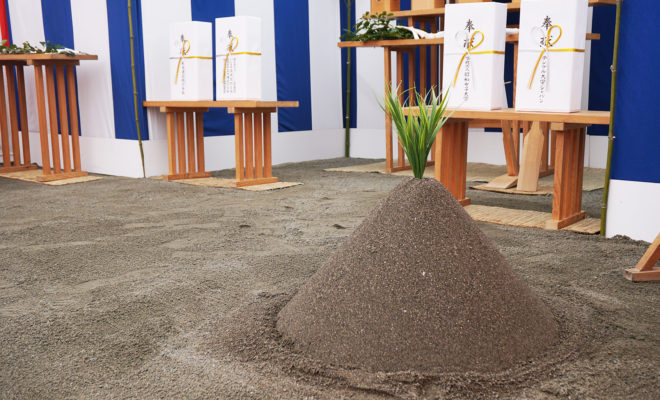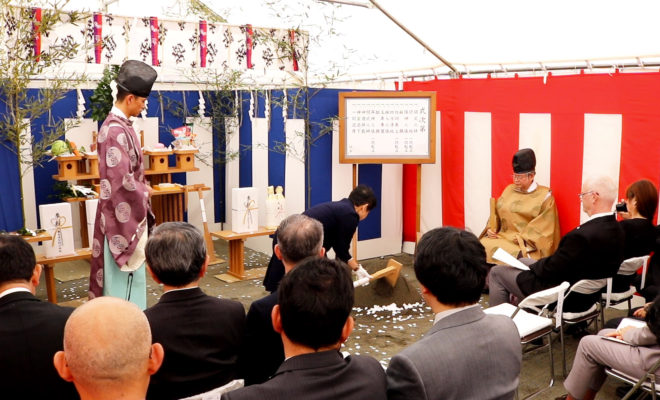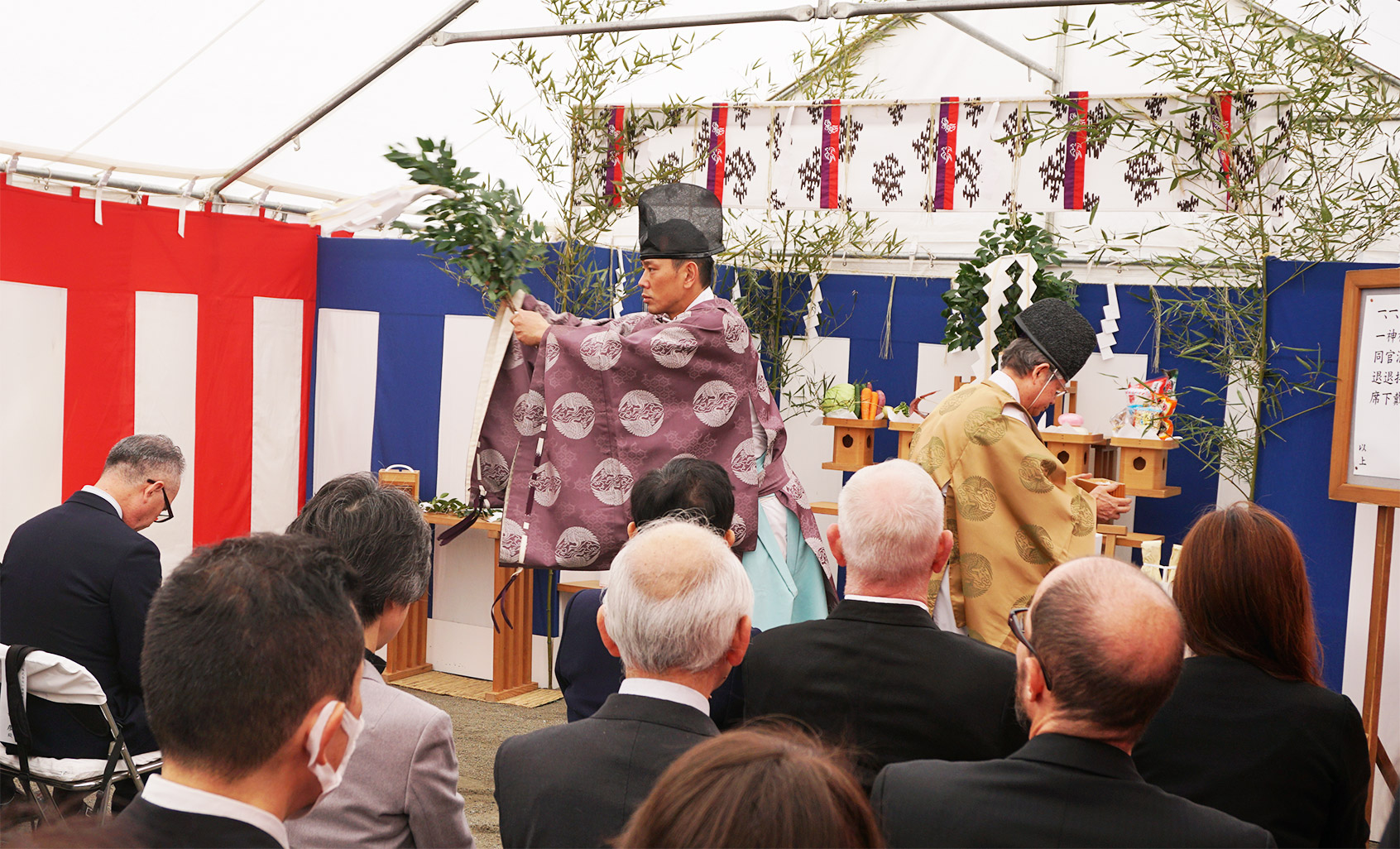Last year, Showa Women’s University (SWU) and Temple University, Japan Campus (TUJ) announced they would share a campus at SWU’s current location in Setagaya-ku beginning Septemeber 2019. On March 13, 2018, the two, alongside Tokyu Construction, gathered at the new campus site to perform the Jichinsai, or groundbreaking ceremony, for the project. The ceremony was held to gain the blessings of the local Kami and mark the beginning of a promising construction schedule. It took place in an on-site, make-shift Shinto shrine.
What is Jichinsai?
Jichinsai are performed before beginning construction on any new building to invite the local Kami, or god, and gain its blessing. Typically, a Shinto priest performs the ceremony on the construction site, with members of each involved party in attendance. The priest purifies the land to prepare for the presence of the Kami, guides the Kami to the site, bestows prayers and gratitude, and finally guides the Kami back to whence it came.

The ceremony is one of the few purely Shinto traditions still performed today, and dates back to well before Buddhism was introduced to Japan. It should therefore come as no surprise that it has become a cornerstone of any construction project in Japan. Having completed the Jichinsai for TUJ’s new campus, workers from Tokyu Construction can feel at ease knowing that any bad luck in the area has been dispelled and that the local Kami has granted them safety and good fortune. And symbolically, the ceremony marks the next step in SWU and TUJ’s ongoing collaboration.
The Ceremony
The ceremony itself took just under thirty minutes to perform, though it took hours of planning to arrange. About forty people attended, including two Shinto priests who performed the Jichinsai.
Before the Ceremony
Before the ceremony, a large red and white tent was erected just outside of the main construction area. This tent served as a sort of temple to house a Shinto himorogi, or temporary shrine, constructed between two bamboo trees. In front of the himorogi, two rows of chairs were placed divided down the middle by an open pathway. This pathway played an important role during the ceremony, serving as the main pathway for the Kami to enter and exit the area.

In addition to the central aisle, offerings to the Kami were set out on the Himorogi. Yamanomono (food from the mountains), uminomono (food from the sea), a bowl of rice and several jars of sake (Japanese rice wine) were arranged on the shrine. To the right of the shrine stood a neatly piled mound of dirt topped with a few blades of grass. This mound served as a representation of the “ground” to be broken. Finally, laid out at the foot of the shrine were wooden tools for “breaking” the mound — a sickle, a hoe and a spade.
During the Ceremony
Upon arriving at the construction site, guests were led into the make-shift temple, and directed to a handwashing area where they were required to have their hands cleansed. Afterward, they were directed to their assigned seats, with higher-ranking and more involved parties seated towards the front. In the front row, Chancellor Mariko Bando, Chairperson Midori Kaneko, and Dean Bruce Stronach sat to the right of the center aisle, with members of Tokyu Construction company seated to the left.

Once everyone was present, the two Shinto priests began the ceremony by offering prayers in front of the shrine. Guests watched in silence as the two began cleansing the area of any bad luck or malicious spirits. One priest waved a sort of wand covered in leaves in the direction of the four corners of the room. The second priest scattered petals on the ground in the same locations.
After the cleansing, the priests began summoning the local Kami. Both priests began chanting in unison, and then suddenly shifted to a steadily rising “ahhhhh” tone. During this time, attendees were asked to stand and bow their heads. The rising tone hit a climax and then steadily decreased until the chanting was complete. And just like that, the Kami had been summoned into attendance.
Breaking the Ground
Once the Kami was summoned, the groundbreaking portion of the ceremony began. One by one, the project manager, Chancellor Bando, and a high-ranking member of Tokyu Construction were called to the front of the shrine and presented with ceremonial tools for striking the ground. First, the project manager was given a sickle with which to cut down the bit of grass located at the top of the dirt mound. Then Chancellor Bando with a wooden spade and the Tokyu Construction representative with a wooden hoe struck the mound itself. In each case the striking was accompanied by three strong shouts, “AY, AY, AY.”

Having broken the “ground,” one of the priests proceeded to call forth a single representative from each SWU, Tokyu Construction and TUJ to pay respects to the Kami. Each were presented with a small wooden relic covered in leaves and directed to the altar while representatives from their respective organizations in the room stood in unison and bowed, clapped, and prayed.
The final portion of the ceremony involved seeing the Kami off, which the priests did using a chant similar to the one used for summoning. This was followed by a celebratory cup of sake for everyone present. Attendees were handed pre-poured dishes of sake, while the six highest ranking members in the front row were served by the Shinto priests themselves. Then everyone drank in unison to the final blessings of the priests.
After the Ceremony
Almost immediately after the completion of the Jichinsai, the atmosphere in the room became much more relaxed. Members from the different organizations turned to one another to offer congratulations and express their gratitude. And then, row by row, attendees exited, starting from the front right and ending with the back left. The ceremony was officially over. Many of the attendees moved on to a reception for the event held on SWU’s campus to celebrate the start of the upcoming construction of TUJ’s new building. Although the ceremony was complete, for TUJ it had marked the next step toward a new global campus, and global future.

